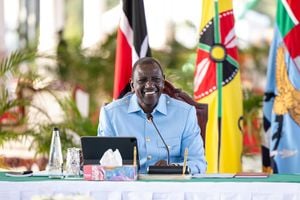Samburu Youth Harness Social Media to Plant Trees

The youngsters are using social media hashtags to mobilize members to voluntarily take part in tree planting exercises in a bid to reduce the effects of climate changes in Samburu County.
What you need to know:
- According to Leseketeti, the youth-led movement began on social media, driven by the urgent need to plant trees to mitigate the impacts of climate change.
- He explains that they are using social media platforms to mobilise like-minded youth who are eager to volunteer for tree-planting initiatives.
It is quite a beautiful scene on a cloudy afternoon as Frank Leseketeti, the founder of Nkopiro Organisation directs hundreds of youth in a tree-planting exercise in the Allamano area of Samburu County.
The rustling of leaves and the soft crunch of soil fills the air as shovels dig into the earth, accompanied by laughter and chatter from the young participants who have come together to plant trees. For years, erratic rainfall and prolonged droughts have ravaged the pastoral region, threatening the livelihoods of the nomadic communities.
But a new wave of environmental activism is emerging among the Samburu youth, with the potential to transform the landscape—both literally and figuratively. According to Leseketeti, the youth-led movement began on social media, driven by the urgent need to plant trees to mitigate the impacts of climate change. He explains that they are using social media platforms to mobilise like-minded youth who are eager to volunteer for tree-planting initiatives.
“While the voluntary tree planting idea had a slow start, it is now gaining momentum, thanks to social media, where young people share their progress," he says. The movement has spread across Samburu County, fuelled by the realisation that this arid region is facing an escalating environmental crisis that demands immediate action. Hashtags like #LetsMakeSamburuGreen, #TreesForTomorrow, and #FromClicks2Progress have become rallying cries on social media platforms.
Purity Koech, one of the youth leaders explained that they use smartphones to capture short video clips and photos, then share on online to rally for more support. “Each post, photo, or video shared under these hashtags tells a story of youth-led determination to plant hope for the future,” she says. The youth regularly visit local schools, churches, public spaces, and degraded parts of Kirisia Forest to plant trees. Purity said they aim to turn tree planting into a popular hobby in Samburu.
Leveraging the power of social media has enabled the movement to attract a diverse group of participants—from university students to local community members of different religious backgrounds. Their efforts are also supported by local organisations and government agencies. The group has also established several tree nurseries with different species to support their mission of greening Samburu, says Purity.
Daniel Dida, also a youth leader in the region, believes that tree planting is the only remedy to mitigate the climate challenges in Samburu County. He notes that the youth are now pushing for large-scale tree-planting initiatives across the arid region to restore the environment and mitigate the impacts of climate change.
When they are not planting trees, the youth focus on educating the community about the importance of environmental conservation. Their efforts align with the government’s ambitious goal of planting at least 15 billion trees by 2032 aiming at achieving 30 percent tree cover in the country.
Officials attached to the Ministry of Environment, Climate Change and Forestry have stated that the government aims to plant at least five billion trees in the next five years, with an additional 10 billion by 2032, to reach the 15 billion mark. In Samburu, the goal is to increase the forest cover to at least 20 percent, up from the current 15 percent.





